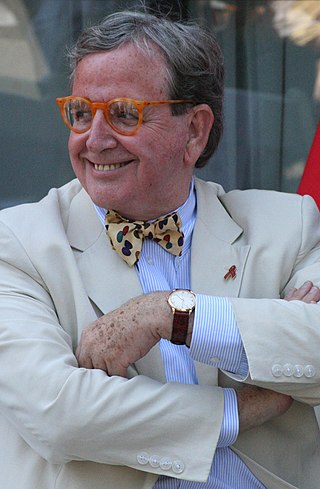
Janet Graham Travell was an American physician and medical researcher.

Burleith is a neighborhood in Washington, D.C., United States. It is bordered by 35th Street NW to the east, Reservoir Road NW and the historic Georgetown district to the south, Whitehaven Park to the north, and Glover Archbold Park to the west. The neighborhood is home to the Duke Ellington School of the Arts and the Washington International School.

Charles Edward Munroe was an American chemist, discoverer of the Munroe effect, and chair of the department of chemistry at the George Washington University.

Judge was a weekly satirical magazine published in the United States from 1881 to 1947. It was launched by artists who had left the rival Puck Magazine. The founders included cartoonist James Albert Wales, dime novels publisher Frank Tousey and author George H. Jessop.

Walter Nathan Tobriner was an American politician who served as the 22nd and final President of the Board of Commissioners of the District of Columbia and a U.S. ambassador.

James McMillan Nielson Graham was a Scottish-born American politician and a member of the Council of the District of Columbia. As a Democrat he represented Ward 1 in Washington, D.C. from 1999 until 2015.

Gilbert Gude was an American politician who served as the U.S. representative for Maryland's 8th congressional district from 1967 to 1977. He was a member of the Republican Party.
The Mount Vernon Seminary and College was a private women's college in Washington, D.C. It was purchased by George Washington University in 1999, and became the Mount Vernon Campus of The George Washington University.
The Greater Washington Board of Trade, founded in 1889, is the region’s premier non-partisan membership organization representing various industry sectors that include, businesses, nonprofits, universities, and government agencies in the District of Columbia, suburban Maryland, and Northern Virginia. The organization focuses on inclusive economic growth, improving the region's business climate, and enhancing economic competitiveness across Greater Washington. Notable organizations and companies that are currently a part of the Board of Trade include Wells Fargo, Georgetown University, Bechtel, The Washington Post, AT&T, Pepco, and many other regional, national, and international organizations.
The GW Hatchet is the student newspaper of the George Washington University. Founded in 1904, The Hatchet is the second-oldest continuously running newspaper in Washington, D.C., only behind The Washington Post. The Hatchet is often ranked as one of the best college newspapers in the United States and has consistently won awards from the Society of Professional Journalists and from the Associated Collegiate Press. Alumni of the GW Hatchet include numerous Pulitzer Prize winners, Emmy Award winners, politicians, news anchors, and editors of major publications.
Dallas Shirley was a basketball referee. He officiated more than 2000 basketball games in his 33-year career, which ended in 1966. He was the International Association of Approved Basketball Officials president from 1952 to 1953. He took part in the 1960 Summer Olympics in Rome, officiating basketball. He was a member of the first NBA officiating crew. He was enshrined in the Basketball Hall of Fame in 1980.

The F Street House is a historic 19th-century mansion in Washington, D.C., blocks away from the White House, that serves as the official residence of the President of the George Washington University. It is a registered landmark on the National Register of Historic Places and was previously known as the Steedman-Ray House, Alexander Ray House, and as the F Street Club.

Roy Lee Williams was an American labor leader who was president of the Teamsters from May 15, 1981, to April 14, 1983.
Pauline "Polly" Ehrlich Shackleton was an American Democratic politician in Washington, D.C. She was elected as one of the original members of the Council of the District of Columbia in 1974 when D.C. gained home rule. She represented Ward 3 on the council from 1975 to 1987.
Nadine P. Winter was a community activist and a Democratic politician in Washington, D.C.
William Lewis Taylor was a Jewish-American attorney, lobbyist and activist who advocated on behalf of African Americans during the Civil Rights Movement and played a major role in drafting civil rights legislation.

The Estelle and Melvin Gelman Library, more commonly known as Gelman Library, is the main library of The George Washington University, and is located on its Foggy Bottom campus. The Gelman Library, the Eckles Library on the Mount Vernon campus and the Virginia Science and Technology Campus Library in Ashburn comprise the trio known as the George Washington University Libraries. The Himmelfarb Health Sciences Library and the Jacob Burns Law Library also serve the university. The Gelman Library is a member of the Washington Research Library Consortium and the Association of Research Libraries.
Gargoyle Magazine is a literary magazine based in Washington, D.C. It was established in 1976 by Russell Cox, Richard Peabody, and Paul Pasquarella. By 1977, Peabody was the only remaining original editor. He continued running the magazine until 1990 with several different co-editors. Before the magazine ceased publication in 1990, 36 issues had been released. It resurfaced in 1997 with Peabody and Lucinda Ebersole as editors and continues to this day.
Elizabeth J. Somers founded the Mount Vernon Seminary in Washington, D.C. in 1875.
Robert S. Sargent (1912–2006) was an electrical engineer, Defense Department defensive weapons specialist, and published poet who lived most of his adult life in Washington, DC.












